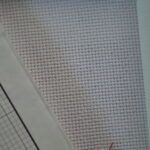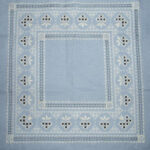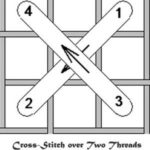Counted cross stitch projects are beautiful and unique. We’re all familiar with samplers and other pieces that can be framed and displayed. But cross stitch techniques can be used to embellish clothing, accessories, toys and more. Learning to cross stitch is rewarding and can allow you to express yourself in treasures that make wonderful gifts and additions to your own home.
The supplies for cross stitching can be purchased at craft stores and online. If your local stores have craft departments, you may snag a deal there as well. Cross stitch fabric comes in various sizes and colors. I recommend buying a large sheet of fabric. You can always cut it into smaller pieces.
In my experience, most brands of embroidery floss are of similar quality. You can choose individual skeins or large packages that contain many colors. It’s helpful to purchase cardboard cards that are meant to hold the floss. Winding your floss on a spool prevents tangles.
You can purchase specialized needles with blunt tips. Because cross stitch fabric is perforated, a sharp point isn’t necessary. However, you may not be able to find a cross stitch needle. Don’t worry! You can use any needle with an eye large enough to accommodate your thread.
While you’re in the craft shop, consider picking up an embroidery hoop. These are designed to keep your fabric taut so that your stitches will be even. You can also use the hoop as a frame if you plan to display your piece.
When you’re ready to try a few stitches, cut a piece of fabric large enough to fit into your embroidery hoop. Err on the side of excess. A too-big piece is a little wasteful, but a too-small piece means you’ll have to cut a new piece. Unscrew the latch at the top of the hoop. This will release the outer loop. Stretch the fabric over the smaller loop, replace the larger piece, and tighten the latch. If your fabric is even, you’re ready.
Most patterns ask for a half-strand of embroidery floss. Take a close look at the end of your floss. You’ll see that it’s made of six small strands. If you stitch with all six strands, your stitches will be thick and raised. It’s much easier to work with three strands at a time. To separate your floss, cut off a long piece and peel it in two. You may want to wrap one strand on another spool to keep it from knotting.
Thread your needle and choose a place to begin your stitches. Pull the floss through one of the holes from the back of the hoop, leaving a 1-2 inch tail on the back. Insert the needle at a diagonal and pull through. Be careful not to pull your tail through. Finish the stitch by repeating in an X shape. Take a look at the picture above to check your stitch.
Repeat your stitches in a line, following the diagram above. Remember to make each stitch identical. If your stitches don’t go in the same direction, it will show on your finished piece. On the back of your project, hold the tail tight against the fabric. Use the loops that your stitches make to cover the tail and hold it in place. We do this because knots can be visible and clutter the back of the fabric, making it hard to stitch neatly.
When you’ve made several stitches, practice finishing. Use the needle to pull the thread under the loops on the back of the fabric. Clip any extra thread closely, being careful not to snip your work. To change colors, simply begin again with a new strand. Follow the original technique.
Your projects will often call for straight stitches. These are simple lines that are used to make edges and lettering. You can practice these stitches along the edges of your practice stitches.
Take a look at the back of your project. It should look neat. If it’s messy, try to practice your stitches, being sure that each stitch is identical. Messy stitches make it difficult to find the perforations in the fabric. This is especially important when a project uses several colors.
Many projects consist of these two stitches alone. Once you’re comfortable, you can start to look at patterns. I recommend one of the small kits that many craft stores carry. They’re inexpensive, simple to understand and can be finished in an hour or two. When you’re finished, you can display your treasure in a child’s room, on a knick-knack shelf, or as a Christmas tree ornament. I’m sure it will be only the first in a succession of wonderful treasures.
Sources: personal experience.




